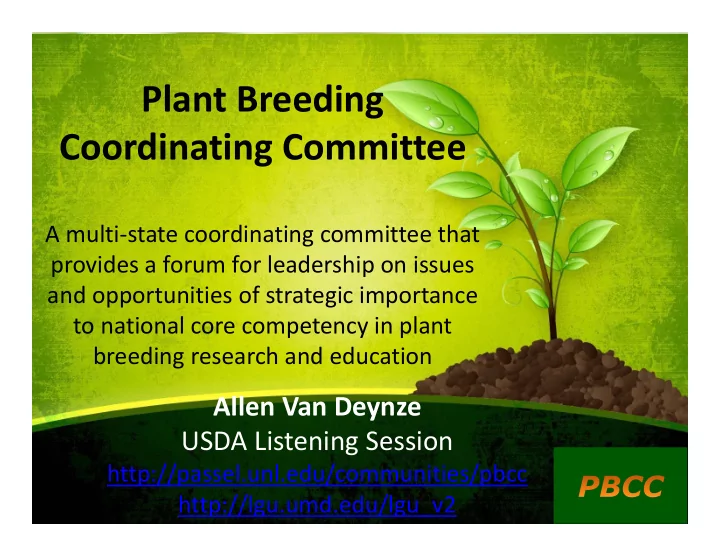

Plant Breeding Coordinating Committee A multi ‐ state coordinating committee that provides a forum for leadership on issues and opportunities of strategic importance to national core competency in plant breeding research and education Allen Van Deynze USDA Listening Session http://passel.unl.edu/communities/pbcc http://lgu.umd.edu/lgu_v2
Plant Breeding a product ‐ oriented discipline of sciences rooted in breeding, quantitative genetics and statistics for crop improvement that encompasses an increasing number of support technologies to sustain society. Plant breeding has Measurable and Tangible Outcomes and Impacts .
Recruiting, Training and Communication “Career decisions are made from hands ‐ on experiences” David Douches, MSU USDA/NIFA Plant Breeding and Education program UC Davis • 2000 students from K ‐ 6 introduced to plant breeding • 100 High School students and >100 freshman undergraduates introduced to plant breeding in the field • 40 videos (sbc.ucdavis.edu) and National Association of Plant Breeders (plantbreeding.org) • 5 Graduate students and interns USDA/NIFA Coordinated Agricultural Projects Education and Extension components (1/3 rd budget) • • Triticeae CAP – Plant Breeding Training Network – 85 graduate students (65 at TCAP institutions, 20 outside grant) – 73 undergraduates (38 at TCAP institutions, 35 at MSIs) – 4 films ( http://passel.unl.edu/communities/pbtn)
Funding mechanisms • Competitive grants • Long ‐ term operational funds ‐ Capacity funds • Infrastructure and equipment funds • Emergency funds
Emergency funds must be timely Citrus Greening Florida industry ‐ $1.54 B US ‐ $2.34 B 2005 ‐ industry begins research 2008 USDA funding
Priorities: Fund the Whole Plate & Nuts
Goals and priorities 2008 Summit 40 experts, Miller et al. 2010 • Decipher the genetic basis of plant environmental responses – G x E • Conserve, characterize and utilize novel germplasm . • Manage complex traits, including quantitative traits • Develop efficient, high ‐ throughput analysis systems • Create knowledge from information • Understand basic genetic mechanisms. • Increase plant efficiency and quality • Improve seed health, quality and performance • Develop cost ‐ efficient risk analysis systems for products of new technologies Surveys ‐ 2009 NAPB, ASTA Seed Summit, 2011
Public and Private Funding • Public funding is essential for basic research and long ‐ term research in plant breeding in all crops • Public funding and infrastructure are essential to train field based plant breeding and agriculture • Although private invests heavily in major commodity and vegetable crops, not all regions or crops are addressed for variety development and germplasm release Glenna, L., W. Lacy, R. Welsh, D. Biscotti. 2007. "Industry perceptions of university ‐ industry relationships related to agricultural biotechnology research." Rural Sociology. 72(4): 608 ‐ 631.
Private partnerships: Survey of 210 researchers and administrators, 9 Univ., 30 Companies. Public Glenna, L., W. Lacy, R. Welsh, D. Biscotti. 2007. "Industry perceptions of university ‐ industry relationships related to agricultural biotechnology research." Rural Sociology. 72(4): 608 ‐ 631. Private
Stripe Rust: 40 ‐ 100% yield loss in 25% of wheat in NW USA in 2008 UC Davis Wheat Program Common Wheat Lassik (HRS): introgression of strong gluten (GluD1 5+10), high grain protein content (GPC ‐ B1), nematode resistance (Rkn3) and stripe rust resistance Yr17 Patwin (HWS): Resistance to new races of stripe rust. Introgression of Yr17 Patwin 515: HWS. Resistance to new races of stripe rust. Two stripe rust resistance gene Yr5 and Yr15 on top of Yr17 Impact : Wheat epidemic currently controlled, Adding UG99 Funding : Hatch, UC Davis, USDA/IFAS, USDA/NIFA, Growers, Private http://passel.unl.edu/communities/pbcc
Tracking Outcomes: USDA/ARS Carrot breeding program Phillip Simon, Madison, WI Carrot Nutritional Value Year Carotene Per capita Est. % of content availability total vitamin A available ------ -------- ----------- ----------- 1975 90 3.7 kg 14 % 2005 130 5.6 kg 21 % One square meter of U.S. carrot production (one crop) is adequate to fulfill vitamin A needs for one adult for one year. Funding : USDA/ARS, USDA ‐ IFAFS, USDA/NIFA, USDA ‐ SCRI, USDA_OREI, Commodity Board, Grower support, Private See http://passel.unl.edu/communities/pbcc
References Brummer, E.C., W.T. Barber, S.M. Collier, T.S. Cox, R. Johnson, S.C. Murray, R.T. Olsen, R.C. Pratt, and A.M. Thro. 2011. Plant breeding for harmony between agriculture and the environment. Frontiers in Ecology and the Environment 9:561 ‐ 568. Woeste, K.E., S.B. Blanche, K.A. Moldenhauer, and C.D. Nelson. 2010. Plant Breeding and Rural Development in the United States. Crop Sci. 50:1625 ‐ 1632. Welsh, R., L. Glenna, W.B. Lacy and D. Biscotti. 2008. "Close enough but not too far: Assessing the effects of university ‐ industry research relationships and the use of academic capitalism." Research Policy. 37:1854 ‐ 1864. Glenna, L., W. Lacy, R. Welsh, D. Biscotti. 2007. "Industry perceptions of university ‐ industry relationships related to agricultural biotechnology research." Rural Sociology. 72(4): 608 ‐ 631. Glenna, L., W. Lacy, R. Welsh and D. Biscotti. 2007. "University administrators, agricultural biotechnology, and academic capitalism: Defining the public good to promote university ‐ industry relationships." The Sociological Quarterly 48(1):141 ‐ 163.
References Miller, J.K., Repinski, S.L., Hayes, K.N., Bliss, F.A., Trexler, C.J. . 2011. Designing Graduate ‐ Level Plant Breeding Curriculum: A Delphi Study of Private Sector Stakeholder Opinion. Journal of Natural Resources & Life Science Education 40:82 ‐ 90. Miller, J.K., and K.J. Bradford. 2010. The regulatory bottleneck for biotech specialty crops. Nature Biotechnology 10:1012 ‐ 1014. Miller, J.K., E.M. Herman, M. Jahn, and K.J. Bradford. 2010. Strategic research, education and policy goals for seed science and crop improvement. Plant Science 179:645 ‐ 652. Repinski, S.L., K.N. Hayes, J.K. Miller, C.J. Trexler, and F.A. Bliss. 2011. Plant Breeding Graduate Education: Opinions about Critical Knowledge, Experience, and Skill Requirements from Public and Private Stakeholders Worldwide. Crop Science 51:2325 ‐ 2336.
Recommend
More recommend